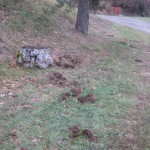A road less shovelled
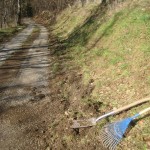 I’m having a pause: one quarter of the road done and too much to go.
I’m having a pause: one quarter of the road done and too much to go.
And that was as far as I got. Days and days have gone past. And to put off finishing the blog I have even gone so far as to tidy my desk and write to the French taxation department over a piece of lost paperwork. But now it’s nose to the grindstone and finish the landscaping news.
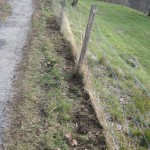 It took a weekend of work, but I have managed to move the turf and soil to parts more worthy: first to the edge of the road closer to the house that has a distinct list to the south. Then up to the orchard for some much needed remedial work.
It took a weekend of work, but I have managed to move the turf and soil to parts more worthy: first to the edge of the road closer to the house that has a distinct list to the south. Then up to the orchard for some much needed remedial work.
It’s rather fun knowing that I may be able to mow this part of the orchard in a few months time. There were plenty of annoyingly large stones lurking in the slope, so I built it up first with rock and then filled in with soil and turf. 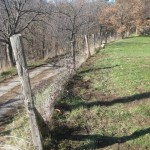
And all this time spent in this part of the grounds had me thinking. Why not put some of those jostaberry cuttings to good use? I had struck some cuttings (show off, I just purned them rather hard a few years back and stuck the twigs in the ground) and they were putting on some typical jostaberry growth.
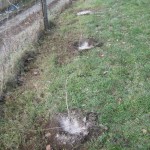 If you don’t know the jostaberry you will not be surprised to learn it’s no beauty. A cross between a blackcurrant and a gooseberry, it produces wonderfully tart fat berries in the late spring. But never seems to suit commercial production as its branches grow all over the place. Not a plant for the neat gardener. But I have plenty of room here, so I planted three cuttings. There are still enough for Nicolas of the two year old and one year old cuttings still up near the potting shed; but it will be fun to see if these three fruit.
If you don’t know the jostaberry you will not be surprised to learn it’s no beauty. A cross between a blackcurrant and a gooseberry, it produces wonderfully tart fat berries in the late spring. But never seems to suit commercial production as its branches grow all over the place. Not a plant for the neat gardener. But I have plenty of room here, so I planted three cuttings. There are still enough for Nicolas of the two year old and one year old cuttings still up near the potting shed; but it will be fun to see if these three fruit.
The white powder is wood ash from the fire. Ought to help things along.
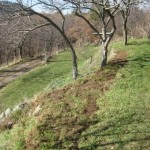 But that brief interlude of creativity was tempered by yet more loads of wheelbarrowing up to the orchard and even further up to the plum trees. I added more topsoil and turf under here too.
But that brief interlude of creativity was tempered by yet more loads of wheelbarrowing up to the orchard and even further up to the plum trees. I added more topsoil and turf under here too.
And finally, finally it was the last trudge and I could look down the road and see it all clear. And ready for the next snow plough damage. Shame about the centre of the road and all those thyme plants that used to be there. But they’ll grow again. Or weeds will.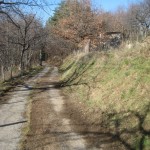
Next up was even more punishing heavy work. Goodness knows why, but the eyesore of the building sand left over from December was irking me.
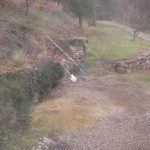 It was the first thing you saw when you turned the car up to the house and parked. This time I hadn’t come up with a cunning plan for making use of the sand. So I have just piled it up near the potting shed. That’s wheel up and over the pebbles (never easy) run along the rickety path through the calabert, up the slope to the shade garden (mind the rock dead centre in the path that’s too big to move) and then stockpile up against the un-used door of the shed. Easy peasy. If you are a builder’s mate.
It was the first thing you saw when you turned the car up to the house and parked. This time I hadn’t come up with a cunning plan for making use of the sand. So I have just piled it up near the potting shed. That’s wheel up and over the pebbles (never easy) run along the rickety path through the calabert, up the slope to the shade garden (mind the rock dead centre in the path that’s too big to move) and then stockpile up against the un-used door of the shed. Easy peasy. If you are a builder’s mate.
And I forgot to mention the sand was damp. Playfully heavy on the spade.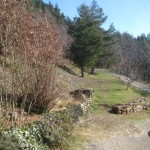
For some soothing recovery work I sowed garlic and onion sets into modules of a mix of compost and mole hill soil. It’s way too cold for them, but if I get a thaw in the next few weeks they may take off a bit earlier than had I planted them directly in the soil.
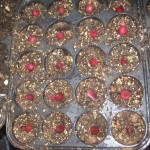 And of course it’s the question of which predator to avoid: deer in the potager or mice in the potting shed. I found one small moribund rodent inside the fish blood and bone fertiliser. Poor thing must have gorged itself to death. It was barely bigger than your thumb, so not a scary thing to dispose of. But it does remind me that I am providing food in the shed in the form of seeds and bulbs. I have plenty more onion sets to sow directly in the soil when it warms up.
And of course it’s the question of which predator to avoid: deer in the potager or mice in the potting shed. I found one small moribund rodent inside the fish blood and bone fertiliser. Poor thing must have gorged itself to death. It was barely bigger than your thumb, so not a scary thing to dispose of. But it does remind me that I am providing food in the shed in the form of seeds and bulbs. I have plenty more onion sets to sow directly in the soil when it warms up.
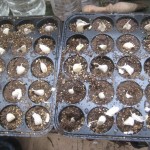
My last task was to remove the sedges that are growng on the edge of the lawn. The plan will be to plant miscanthus sinensis here instead. It will be a bit of a scavanging hunt for the first bit: I have about eight or nine grasses elsewhere that can be transplanted. 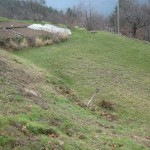
And to finish this rushed post (I have a plane to catch) here is the latest picture of the advance of the wild boar. They were in the east garden last night. About ten metres from the house. Urgh.
